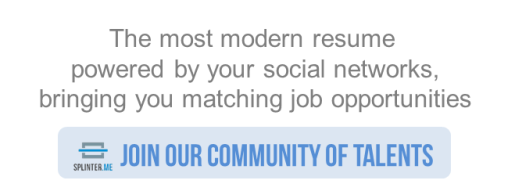We spend a great amount of time of our lives at work. And lately we are changing jobs more and more often, culminating with an average of 3 years between job changes registered among the Y generation. The line between active and passive job seekers became blurry as well, since 3 in 4 people that are currently employed are either actively searching for a job or are open to new opportunities (1). Needless to say how important job searching is for professionals in these conditions, with everything it involves: the resume building, the job searching itself and the application process.
And with all its importance, recruitment did not actually benefit much from the technology development. Since the World Wide Web was born in the beginning of the 90s, there were only two notable milestones until recently:
- The creation of job boards (Monster launched in 1994, CareerBuilder in 1995, StepStones in 1996) and job aggregators (Indeed and Simply Hired launched in 2004 and 2005).
They survived until nowadays, with 67% of the people still searching on job boards (1). While their success was defined by the impressive growing numbers of job posts and applications attracted, this lead to the increase of time and effort needed to be spent by both job seekers and recruiters to “find the needle in the haystack”.
- The creation of social networks (like Facebook, Twitter and directly related to recruitment – the professional social network, LinkedIn, launched in 2003) and various online platforms related to professionals purposes (like GitHub, launched in 2008).
With all the emerging use of social networks (counting Facebook with 1B users, LinkedIn with 200M users etc.) where people post information about their activities and interests, recruiters started to be more and more interested in reaching candidates on social media. In 2012, 92% of recruiters said they were using or planning to use social media for recruiting (2).
Social recruiting concept started to emerge lately but “it is a contested term”, as Wikipedia would call it. “The most common definition used for social recruiting is that it is the process of sourcing or recruiting candidates through the use of social platforms as promotional and/or advertising channels by employers and recruiters.” (wikipedia) However, 1 in 3 job seekers were less optimistic in 2012 than 2011 when it came to finding the right job (3).
Although most social recruiting platforms fall under this category, there is another category which includes splinter.me: “internet sourcing using social media profiles, blogs, and online communities to find and search for passive candidate data and information.” (wikipedia)
The real disruption started to happen now, with new social recruiting tools that actually use big data and machine learning to help professionals build one profile that aggregates all their relevant information from their online activities and receive job opportunities that really fit their profile. And this is what splinter.me is here for (under development at the moment).
And with a profile like this, don’t imagine employers will see your pictures from your latest party, but your professional interests, skills and expertise (because the system is filtering relevant data from your social networks to add to your profile).
splinter.me will help professionals in two ways:
- Easy and pleasant profile building. No more empty text boxes to fill. Grant us access to your social networks and we will do the work for you. Your profile will be constantly updated with your interests, skills, expertise and experience from every corner of your online presence. And flavor it with the workstyle test results we offer through our partners.
- Time saving matchmaking with work opportunities. No more manual job search to find interesting opportunities and no more analysis if you are meeting the job requirements. Because you will have a very information-rich profile on splinter.me, we will be able to send you jobs that really fit.
Sources:
- CareerBuilder’s “Candidate Behaviour” study made in 2012 on a Canadian and American full-time workers representative sample.
- Jobvite’s “Social Recruiting Survey” study made in 2012 on 1000 recruiters across the globe.
- Jobvite’s “Job Seeker” study made in 2012 in the United States.
Related Posts
Comments
comments



![[study] How important your social media profiles have become for your career](/wp-content/uploads/2013/09/socialmediahiring0-150x150.png)



